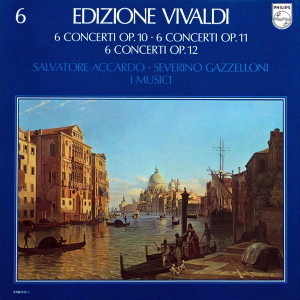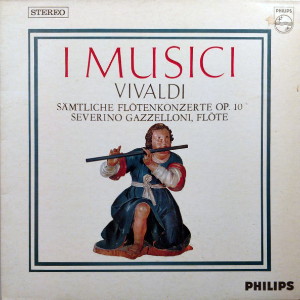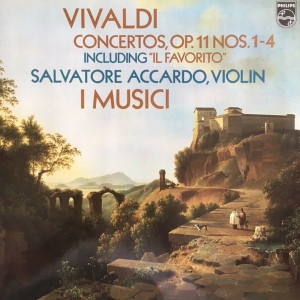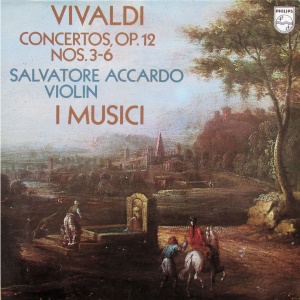 |
|
4 LP's
- 6768 012 - (c) 1978
|
 |
| 1 LP -
839 726 - (p) 1968 |
 |
| 1 LP -
6500 933 - (p) 1975 |
 |
| 1 LP -
6500 934 - (p) 1975 |
 |
| 1 LP -
6500 937 - (p) 1975 |
|
| EDIZIONE
VIVALDI - Vol. 6 |
|
|
|
|
|
|
|
| Antonio
Vivaldi (1678-1741) |
|
|
|
|
|
|
|
| Long Playing
1 |
|
53' 25" |
|
6 Concerti für
Flöte, Streicher und Continuo op.
10
|
|
|
|
| -
Concerto Nr. 1 F-dur "La tempesta di
mare", RV/R. 433 (P. 261) |
7' 42"
|
|
|
| -
Concerto Nr. 2 g-moll "La notte",
RV/R. 439 (P. 342) |
10' 13" |
|
|
| -
Concerto Nr. 3 D-dur "Il cardellino",
RV/R. 428 (P. 155) |
9' 36" |
|
|
|
|
|
|
| -
Concerto Nr. 4 G-dur, RV/R. 435 (P.
104) |
7' 26" |
|
|
| -
Concerto Nr. 5 F-dur, RV/R. 434 (P.
262) |
9' 51" |
|
|
| -
Concerto Nr. 6 G-dur, RV/R. 437 (P.
105) |
8' 37" |
|
|
Long Playing
2
|
|
49' 31" |
|
| 6
Concerti für Violine, Streicher
und Continuo op. 11 |
|
|
|
| -
Concerto Nr. 1 D-dur, RV/R. 207 (P.
156) |
9' 26" |
|
|
| -
Concerto Nr. 2 e-moll "Il favorito",
RV/R. 277 (P. 106) |
15' 39" |
|
|
|
|
|
|
| -
Concerto Nr. 3 A-dur, RV/R. 336 (P.
216) |
11' 47" |
|
|
| -
Concerto Nr. 4 G-dur, RV/R. 308 (P.
107) |
12' 39" |
|
|
| Long Playing
3 |
|
48' 34" |
|
| -
Concerto Nr. 5 c-moll, RV/R. 202 (P.
417) |
14' 07" |
|
|
| -
Concerto Nr. 6
g-moll, RV/R. 334
(P. 339) |
11' 59" |
|
|
|
|
|
|
| 6
Concerti für Violine, Streicher
und Continuo op. 12 |
|
|
|
| -
Concerto Nr. 1
g-moll, RV/R. 317
(P. 343) |
12' 28" |
|
|
| -
Concerto Nr. 2
d-moll, RV/R. 244
(P. 263) |
10' 00" |
|
|
| Long Playing
4 |
|
42' 26" |
|
| -
Concerto Nr. 3
D-dur, RV/R. 124 (P.
157) |
6' 37" |
|
|
| -
Concerto Nr. 4
C-dur, RV/R. 173 (P.
11) |
10' 35" |
|
|
|
|
|
|
| -
Concerto Nr. 5
B-dur, RV/R. 379 (P.
344) |
11' 42" |
|
|
| -
Concerto Nr. 6
B-dur, RV/R. 361 (P.
345) |
13' 32" |
|
|
|
|
|
|
| Concerti op. 10 |
Concerti op. 11
& 12 |
|
| Severino
Gazzelloni, Flöte |
Salvatore Accardo, Violine |
|
| Maria Teresa
Garatti, Cembalo |
I MUSICI |
|
| I MUSICI |
|
|
|
|
|
|
Luogo
e data di registrazione |
|
Vevey
(Svizzera) - giugno 1968 (op. 10)
La Chaux-de-Fonds (Svizzera) -
luglio 1974 (op. 11)
La Chaux-de-Fonds (Svizzera) -
luglio 1978 (op. 12, 1-2)
La Chaux-de-Fonds (Svizzera) -
settembre 1974 (op. 12, 3-6)
|
|
|
Registrazione: live /
studio |
|
studio |
|
|
Producer / Engineer |
|
- |
|
|
Prima Edizione
originale LP |
|
Philips
- 839 726 - (1 LP) - durata 53'
25" - (p) 1968 - Analogico - (op.
10)
Philips - 6500 933 - (1 LP) -
durata 49' 31" - (p) 1975 -
Analogico - (op. 11, 1-4)
Philips - 6500 934 -
(1 LP) - durata 48' 34" - (p)
1975 - Analogico - (op. 11, 5-6
& op. 12, 1-2)
Philips - 6500 937 -
(1 LP) - durata 42' 26" - (p)
1975 - Analogico - (op. 12, 3-6)
|
|
|
Note |
|
-
|
|
|
|
|
|
|
CONCERTOS,
OP. 10
Vivaldi seems to have
composed with unbelievable
facility and speed. We are
told that he could write
the score of a concerto
quicker than the copyist
could transcribe it. In
the concerto, he did not
bind himself to one
specific form, like, for
instance, Corelli who
constructed his concertos
on the principle of
”timbre arrangement,” or
Torelli who differentiated
thematically between solo
and tutti.
To describe Vivaldi's
wealth of varied forms is
not possible in a few
words. There are concertos
of his in which the solo
and ripieno parts
are strictly defined in
wellbalanced phrases and
others where the solo
springs in small particles
from the whole.
Vivaldi's style of
composition is closely
connected with the
concertante element. His
music is vigorous and
sensitive. It
has completely avoided the
restrictions of the fugal
manner of older masters,
and is built for the most part
on a homophonic basis.
Vivaldi liked to keep the
upper parts and bass
distinct from each other,
both in rhythm and
motives. Now and then, he
has solo passages
accompanied by unison
violins only, without
sustained basses, after
the Neapolitan custom,
and, like all Venetians,
he loves the big
impressive unison passages
at the beginning of a
movement. These are true
Baroque practices, which
frequently indicate the
character of a piece in a
few notes.
The concertos for flute,
strings, and continuo of
Op. 10 appeared in
Amsterdam in 1729,
published by Le Cène.
The first three concertos
bear the titles “La
tempesta di mare” (Storm
at Sea), "La notte"
(Night), and “Il
cardellino” (The
Coldfinch).
We often find such titles
in Vivaldi's music, for
example in the “Four
Seasons” of Op. 8. They
suggest portraits from
nature, which have always
been popular in any age.
Few composers, however,
have been granted the
ability to bind such
pictures so strongly and
convincingly into a formal
framework, and to make
them accord so happily
with musical precepts that
they do not degenerate
into flat, superficial
programme music for its
own sake.
From a rich store of
effects and oratorical
turns of expression,
Baroque music creates
so-called loci topici,
which enable it to render
any human sentiments and
events of nature which
would be rightly
understood by the
intelligent listener of
that era familiar with
their use.
We are today too easily
inclined to thrust the
programme aspect of these
objective titles into the
foreground. They should,
however, be regarded far
more as supplementary
expression marks. It is
certainly possible that
they also lent wings to
Vivaldi's imagination, yet
rather do they serve to
provide a “crib” for the
executive musician, as he
has to modify certain
tempos and emotions far
more drastically to accord
with a specific title than
would be the case with
abstract expression marks
like andante spiritoso,
allegro molto,
etc..
Thus the title of the
first concerto in F,
“Storm at Sea,”
immediately evokes a
temperamental, flashing Allegro,
and the tempestuous Presto,
which begins in unison, is
carried out in the same
vein. The middle movement,
with its tranquil flute
solo and dotted-rhythm
accompaniment provides a
strongly effective
contrast. There is a
similar piece, under the
same title, in the
aforementioned Op. 8.
The second concerto, in G
minor, finds a counterpart
in a bassoon concerto,
which has come down to us
in manuscript. While the
latter is in the classical
three-movement form,
Vivaldi divides the Op. 10
flute concerto into
smaller episodes,
contrasting in tone and
character, of which the
second is entitled
“Fantasmi” (which might be
translated as “visions” or
"apparitions”), and the Largo,
with its sustained notes
and scoring for muted
strings, “Sleep.”
The third concerto of the
series, “The Coldfinch,”
is an exceptionally gay
and light-hearted piece.
Vivaldi's
technique here is very
interesting. He constructs
almost the entire first
movement out of the dotted
motive in the strings and
the triad upon which the
part for solo flute is
built.
The fourth and fifth
concertos are of a
pleasant, mildly toned and
agreeable character,
accommodating themselves
to the pastoral nature of
the flute. In
the first movement of the
concerto in F true Vivaldi
dynamics are revealed in
the chromatic motive over
a sustained bass, and
there is a real daemonic
element in the G minor Largo.
The sixth and last
concerto begins with a
theme in unison extending
over more than an octave.
The same "Cardellino"
motive as in the third
concerto eventually
emerges in the flute solo.
In
the second movement
Vivaldi states an
eight-bar theme in C
minor, which he changes to
the major in the next
movement and then works
out in variations over an
ostinato bass. This
manner of composition was
otherwise customary only
in the suite form. Here
Vivaldi, in a most
original way, takes it
over in the concerto.
Franz
Giegling
CONCERTOS,
OP. 11 AND OP. 12
On September 2, 1729 an
advertisement appeared in
the “Gazette d’Amsterdam”
for 12 newly-published
concertos by Antonio
Vivaldi, described as
“Opera undecima e
duodecima, XII
Concerti a tre violini,
alto viola, violoncello e
organo.” (It
should be explained that
“tre violini” was a common
shorthand for a principal,
i.e. solo, violin part and
two orchestral parts, and
that “organo” denoted any
appropriate keyboard
continuo instrument.) We
know from the title pages
of the two collections
that they were engraved at
the expense of
Michel-Charles Le Cène,
head since 1722 of the
publishing firm to which
Vivaldi had entrusted his
Op. 3-10. Interestingly,
Op. 10-12 are allotted the
consecutive numbers
544-546 in Le Cène’s
catalogue, implying
consecutive publication,
though Op. 10 - the
celebrated set of six
flute concertos -
presumably appeared a
little earlier as it is
not mentioned in the same
advertisement.
Whenever there is no clear
evidence (such as a
dedication) of an
eighteenth-century
composer’s personal
involvement in the
publication of music under
his name, the possibility
may exist that the works
were at best acquired
through third parties or
at worst written by
someone else. The direr
possibility need not
concern us, for the
present works are genuine
enough, but a couple of
points cause one to
question whether in actual
fact the works were
submitted by their
composer to Le Cène
in two sets of six, or at
least whether they were
not perhaps subdivided by
the publisher in an
originally unintended
manner. For a start, the
last concerto of Op. 11 is
a new version with oboe
soloist of a work
published in 1727 with
violin soloist as the
third concerto of
Vivaldi's Op. 9, “La
Cetra.” Vivaldi was as
fond as Handel of
borrowing from himself,
but he usually took care
for obvious reasons not to
duplicate the works he
sent to Amsterdam for
publication - works upon
which his reputation
abroad would principally
depend. Then the two
adjacent works in B flat
at the end of Op. 12 are a
curious anomaly. When
composers did not entirely
avoid the repetition of a
key in a set of six or 12
works they made a practice
of keeping any two works
in the same key apart from
one another. For example,
the two C major works in
Vivaldi's
Op. 8, "Il
cimento dell’armonia e
dell’invenzione,"
lie in sixth and twelfth
place, the two C minor
works in second and eighth
place. Publishers acting
on their own account were
less solicitous, as
several anthologies show.
On the other hand, the
heterogeneity of style and
instrumental specification
is entirely typical of
Vivaldi's published sets,
for most if not all of
them were put together
(often after some
revision) from works
already tried and tested
in performance rather than
composed from scratch.
Thus three of the present
works (Op. 11 Nos. 1 and 3
and Op. 12 No.
5) have autograph
concordances in the Turin
manuscripts, generally
thought to represent
Vivaldi's working
collection built up during
his years of service at La
Pietà,
the Venetian charitable
institution which combined
the functions of an
orphanage for girls and a
musical conservatory.
Vivaldi specialised in
playing the violin in
extremely high positions
(an incredulous eyewitness
reports in 1715 how he
“placed his fingers a mere
hair”s breadth from the
bridge so that there was
scarcely any room for the
bow”!),
and it is significant that
all three works take the
soloist up to A or even B
flat in altissimo.
Two other concertos - Op.
11 Nos. 2 (with the
original nickname of “Il
favorito”) and 5 - appear
with different finales in
the manuscript set of
violin concertos entitled
“La Cetra” (on no account
to be confused with the
published collection of
the same name), copied out
in 1728 for Emperor
Charles VI, with whom the
composer enjoyed a close
relationship. The solo
writing in these two
concertos is exceptionally
intricate. The remaining
works conform to the
general run of Vivaldi's
published concertos by
cultivating a rather
“classical” virtuosity
which avoids the
extravagances found in
many of the concertos
remaining in manuscript.
One concerto, Op. 12 No.
3, dispenses with a
soloist altogether; it
belongs to the important
category of “ripieno
concerto, ” of which
Vivaldi produced over 50
examples, if we may
include compositions used
as operatic overtures.
These works give the lie
to the widespread belief
that Vivaldi was a
composer who habitually
thought "harmonically"
rather than "contrapuntally";
let it be noted that all
three movements of the
present concerto are
severely - even
audaciously -
contrapuntal, the finale
being a full-scale fugue!
In view of their
originality and quality it
is strange that none of
Vivaldi's other ripieno
concertos were published.
The case of the solitary
oboe concerto (Op. 11 No.
6) is entirely different,
as Vivaldi (or his
publishers) had already
cashed in on the
popularity of this novel
genre following the
appearance in 1715 of
Tomaso Albinoni’s
Concerti a cinque, Op. 7
(containing eight single
or double oboe concertos),
by including a pair of
works with oboe in both
Op. 7 and Op. 8, thereby
setting a precedent.
The structure of the fast
outer movements in
Vivaldi’s solo concertos
is standardised in outline
but variable in detail.
The tutti always
open with an imposing
paragraph, termed
ritornello, in the home
key; this reappears at
intervals thereafter in
various keys, often in
abridged form or with its
constituent elements
rearranged. Between tutti
statements the soloist
enters the arena. Whereas
Vivaldi's imitators
usually keep the length of
alternating tutti
and solo portions roughly
constant, Vivaldi himself
has a pronounced tendency
to expand the length of
the solo episodes
progressively while
curtailing the ritornellos. The
soloist gradually takes
charge of the movement, as
it were, although the tutti
are always granted the
final word.
Another peculiarity of
Vivaldi's solo episodes is
the abruptness of their
changes of rhythm and
especially of harmonic
rhythm: having dreamily
elaborated a single chord
for several bars, the
soloist will suddenly
spring to life and pass
with great rapidity from
chord to chord.
Unpredictability - the
sense of adventure - is a
major feature of Vivaldi’s
style.
The slow movements are
more varied in type. One
(in Op. 11 No. 3) is a
binary movement in two
repeated sections. The
others are unitary (i.e.
through-composed)
movements, some featuring
short tutti
ritornellos. The scoring
of the accompaniment to
the soloist attests the
vitality of Vivaldi's
imagination, for few
movements employ the
identical formula. What
the diverse sorts of
accompaniment have in
common is a lightening and
simplification of the
texture which enables the
soloist to embellish his
part at pleasure with the
minimum constraint.
Sometimes the lower
instruments and continuo
are suppressed, leaving
the viola to play the bass
line - as in Op. 12 Nos. 1
and 2; sometimes the
accompaniment is reduced
to two strands as in Op.
12 Nos. 4 and 6 -
sometimes even to a single
strand played on cello
(often doubled by
continuo) or upper strings
as in Op. 11 Nos. 3 and 5.
Vivaldi popularised the
device of playing a simple
bass line on violins in a
high register without
continuo support. C.P.E.
Bach roundly condemned the
practice and referred
disapprovingly to “A
certain master in Italy,”
whom he held responsible
for its introduction, but
when used in the right
place it can produce an
attractive luminosity of
timbre attainable in no
other way. The commonness
of ostinato
patterns in the
accompaniment is
noteworthy: the slow
movement of Op. 11 No. 6
is even constructed over a
modulating ground bass, a
device familiar from the
slow movement of Vivaldi's
Concerto in A minor, Op. 3
No. 8.
The choice of key for the
slow movements may
surprise, for two-thirds
of them remain in the
principal tonality of the
work. In
the early part of the
century the relative major
or minor key (retained in
Op. 11 No.1 and Op. 12 No.
3) was easily the most
popular key, offering as
it did a contrast of mode.
By the 1720’s,
however, the average
dimensions of concertos
had increased so much
(hence the publication of
their parts in volumes
containing only six rather
than the full 12 works)
that contrast within
movements was becoming as
important as contrast
between movements. Since
the relative key would be
visited as a matter of
course in the outer
movements its presence in
the central movement would
produce less impact than
formerly. Composers
therefore felt free to
choose keys either more
distant from the principal
tonality or closer to it -
in the present case
identical with it. Such
“homotonality” was later
to prove a characteristic
of some of Haydn’s most
powerful works.
Op. 11 and Op, 12 are not
in a literal sense
Vivaldi's swansong in the
realm of the concerto, for
as late as 1740, one year
before his death, he was
still writing concertos
for special occasions.
However, they contain his
last instrumental works to
bear an authentic opus
number. Already aged over
50, he had ceased to
regard instrumental music
as his principal area of
activity and was
increasingly turning to
the composition and
promotion of opera. This
may in part explain the
absence of new concerto
publications during the
1730’s.
Or perhaps the rise of
younger virtuosos such as
Locatelli and Leclair,
whose formidable technical
demands on the soloist
easily outstripped those
of the Venetian master,
may have counselled
prudence. But whatever the
reasons, we could hardly
take our leave of Vivaldi
the concertist in happier
circumstances, for the 12
works in Op. 11 and Op. 12
are all worthy specimens
of his art. True, the
highest degree of
perfection - that of a
Bach - is a quality they
cannot be claimed to
possess; nor do they
really aspire to it, for
it is in Vivaldi's nature
to sacrifice refinement of
detail to immediacy of
communication. Like
certain other great
composers whose
compositional technique is
by normal standards not
beyond reproach - Berlioz
and Schumann spring to
mind - he finally manages
to convince us through the
sheer force of his
personality.
Michael
Talbot
|
|

